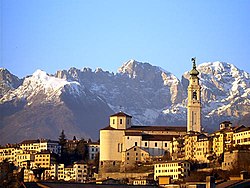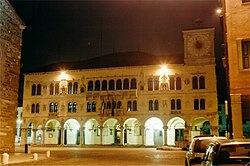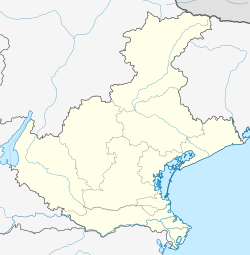Belluno
Belluno | |
|---|---|
| Città di Belluno | |
 Panorama of Belluno | |
| Coordinates: 46°08′25″N 12°13′00″E / 46.14028°N 12.21667°E | |
| Country | Italy |
| Region | Veneto |
| Province | Belluno (BL) |
| Frazioni | see list |
| Government | |
| • Mayor | Jacopo Massaro |
| Area | |
| • Total | 147.18 km2 (56.83 sq mi) |
| Elevation | 390 m (1,280 ft) |
| Population (December 2012)[2] | |
| • Total | 35,328 |
| • Density | 240/km2 (620/sq mi) |
| Demonym | Bellunesi |
| Time zone | UTC+1 (CET) |
| • Summer (DST) | UTC+2 (CEST) |
| Postal code | 32100 |
| Dialing code | 0437 |
| Patron saint | Saint Martin |
| Saint day | 11 November |
| Website | Official website |


Belluno [belˈluːno] (Italian: Belluno, Template:Lang-lld, Template:Lang-vec), is a town and province in the Veneto region of northern Italy. Located about 100 kilometres (62 miles) north of Venice, Belluno is the capital of the province of Belluno and the most important city in the Eastern Dolomiti's region. With its roughly 36,000 inhabitants, it is the largest populated area of Valbelluna. It is one of the 15 municipalities of the Dolomiti Bellunesi National Park.
Together with other Alpine towns, Belluno engages in the Alpine Town of the Year Association for the implementation of the Alpine Convention to achieve sustainable development in the Alpine Arc. Belluno was named Alpine Town of the Year in 1999.
Geography
The ancient city of Belluno rises above a cliff spur near the confluence of the Torrente Ardo and the Piave River. To the north is the imposing Schiara range of the Dolomites, with the famous Gusela del Vescovà (Bishopric's needle), and Mounts Serva and Talvena rising above the city. To the south, the foothills of the Alps separate Belluno from the Venetian plain. Further to the south is the Nevegal, in the Castionese area, well known for its skiing resorts. The average annual temperature in Belluno is 9 °C (48 °F), and the average annual precipitation is 137 cm (54 in).
History
The name of the city is derived from Celtic belo-dunum which means "splendid hill."[citation needed] The name was inspired by the favorable position within the valley.
It is conjectured that the population of the area that became Belluno was largely Venetic with a strong Celtic minority. However, as the Romans expanded northward into the Alps, the Celtic either emigrated or were absorbed. The people of the area swore friendship to Rome in the 225 BC conflict with the Gauls and again during the invasion by Hannibal in the Second Punic War.
Founded perhaps around 220-200 BC the initial influence of Rome was military and commercial. Strategically located, the town protected cities to the south. Belluno also became a supplier of iron and copper. Already within the Roman sphere of influence, the town was juridically and polictically incorporated into the Roman Republic by the second century BC.
Sometime between the death of Julius Caesar and the ascent of Augustus, Bellunum became a Roman municipium and its people were ascribed to the Roman tribe Papiria. The town was ruled by quattorviri juri dicendo, by quattorviri aedilicia potestate, and by a Council of Elders. Under Augustus, it became part of Regio X Venetia et Histria. Among its citizens were Caius Flavius Hostilius and his wife Domitia, whose 3rd century sarcophagus lies next to the church of San Stefano.
After the fall of the Western Roman Empire, it was ruled by the Lombards (6th century) and the Carolingians (8th century); the famous Belluno Treasure in the British Museum dates from this period. From the late 9th century it was ruled by a count-bishop and it received a castle and a line of walls. Later it was a possession of the Ghibelline family of the Ezzelino. After having longly contended the nearby territory with Treviso, in the end Belluno gave itself to the Republic of Venice (1404). The city was thenceforth an important hub for the transport of lumber from the Cadore through the Piave river. It remained Venetian until 1797.[3] After the fall of the Republic, Belluno was an Austrian possession, until it was annexed to the Kingdom of Italy in 1866.
The cathedral was much damaged by the earthquake of 1873, which destroyed a considerable portion of the town, though the campanile stood firm.[3]
Main sights
- The Duomo (Cathedral, 16th century), with the 18th-century bell tower designed by Filippo Juvarra. The church's plan is attributed to the Venetian architect Tullio Lombardo
- Palazzo dei Rettori (1491)
- The red edifice of the Communal Palace
- The Bishop's Palace, erected in 1190 by the count-bishop Gerardo de' Taccoli
- The Fountain of Piazza del Duomo
- Baroque church of San Pietro (1326), originally in Gothic style. It includes five paintings by Andrea Schiavone, three by Sebastiano Ricci.
- Palazzo del Capitano
- The 16th-century church of San Rocco
- The church of Santo Stefano, housing several 15th-century paintings by local masters. It also includes an Adoration of the Magi, from Tiziano's workshop.
- The Romanesque church of San Biagio
- The Porta Dojona and Porta Rugo gates in the ancient walls
- The 16th-century church of Santa Maria dei Battuti
Frazioni
Antole, Bes, Bolzano Bellunese, Caleipo-Sossai, Castion, Castoi, Cavessago, Cavarzano, Cet, Chiesurazza, Cirvoi, Col di Piana, Col di Salce, Collungo, Cusighe, Faverga, Fiammoi, Giamosa, Giazzoi, Levego, Madeago, Miér, Nevegal, Orzes, Pedeserva, Pra de Luni, Rivamaor, Safforze, Sala, Salce, San Pietro in Campo, Sargnano, Sois, Sopracroda, Sossai, Tassei, Tisoi, Vezzano, Vignole, Visome.
Quarters
Baldenich, Borgo Garibaldi (or Via Garibaldi), Borgo Piave, Borgo Prà, Cavarzano, Lambioi, Mussoi, Quartier Cadore, San Lorenzo, San Pellegrino, San Francesco, Via Cairoli, Via Feltre-Maraga, Via Montegrappa.
Transport
State roads lead from Belluno to Feltre, Treviso, Ponte nelle Alpi and Vittorio Veneto.
Belluno railway station, at Piazzale della Stazione, forms part of the Calalzo–Padua railway. It was opened in 1912, and replaced an earlier station opened in 1886. Its passenger building, designed by the architect Roberto Narducci, was constructed in 1928.
The bus station is also at the Piazzale della Stazione, next to the railway station.
Notable residents
- Marco Paolini (b. 1956), stage actor
- Dino Buzzati (1906–1972), novelist and journalist, born in Belluno
- Pope Gregory XVI (1765–1846)
- Andrea Brustolon (1662–1732), sculptor
- Ippolito Caffi (1809–1866), painter
- Sebastiano Ricci (1659–1734), painter
- Marco Ricci (1676–1730), painter
- Luigi Luca Cavalli Sforza (b. 1922), human geneticist, pioneer of human genome project
- Pope John Paul I (1912-1978)
- Bernardino Vitulini, painter
International relations
Twin towns and sister cities
Belluno is twinned with:
 Cervia, Italy
Cervia, Italy Bend, Oregon, United States
Bend, Oregon, United States
References
- ^ "Superficie di Comuni Province e Regioni italiane al 9 ottobre 2011". Italian National Institute of Statistics. Retrieved 16 March 2019.
- ^ "Popolazione Residente al 1° Gennaio 2018". Italian National Institute of Statistics. Retrieved 16 March 2019.
- ^ a b One or more of the preceding sentences incorporates text from a publication now in the public domain: Chisholm, Hugh, ed. (1911). "Belluno". Encyclopædia Britannica. Vol. 3 (11th ed.). Cambridge University Press. p. 710.



